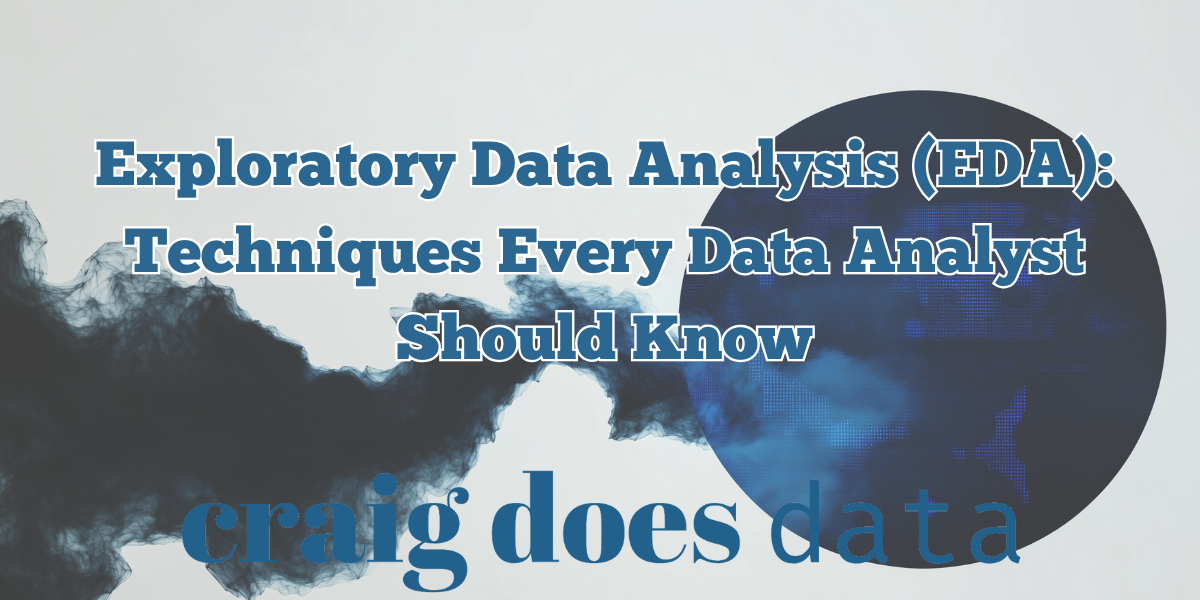
Exploratory Data Analysis (EDA): Techniques Every Data Analyst Should Know
Exploratory Data Analysis (EDA) is a critical step in the data analysis process that allows analysts and data scientists to make sense of raw data. Through an iterative cycle of summarizing, visualizing, and interpreting information, EDA helps professionals discover insights, detect anomalies, and form hypotheses about the underlying patterns in their datasets. In an era where data-driven decision-making is the norm, mastering EDA techniques can significantly improve the accuracy, efficiency, and clarity of your data projects.
Whether you are a seasoned data analyst, a budding data scientist, or simply someone curious about making data-backed decisions, understanding EDA is vital. By focusing on both the statistical and visual aspects of data, you can reveal hidden relationships, confirm or challenge assumptions, and set the stage for more advanced data analysis tasks—such as predictive modeling and machine learning.
In this in-depth article, we will explore key EDA techniques every data analyst should know. From organizing and cleaning raw data to visualizing multivariate relationships and detecting outliers, each step provides invaluable insights that guide the rest of your analysis. By the end, you will have a robust toolbox of methods, strategies, and best practices that you can apply to your own data projects, ultimately empowering you to make more informed, evidence-based decisions.
1. Understanding Exploratory Data Analysis (EDA)

Exploratory Data Analysis (EDA) is an approach introduced by the statistician John Tukey, emphasizing the importance of exploring data to uncover patterns before jumping into formal modeling or hypothesis testing. At its core, EDA revolves around understanding the structure of your dataset, identifying the main characteristics that stand out, and preparing for subsequent, more rigorous analyses. While it may appear straightforward—reading data files and creating a few plots—effective EDA is a meticulous process that can profoundly influence the trajectory of your entire project.
In the data analysis lifecycle, EDA typically follows data collection and precedes more advanced tasks such as modeling. It sets the stage by helping you understand data distributions, relationships between variables, and any potential pitfalls like missing or corrupt values. The objectives of EDA are diverse:
- Uncovering patterns: Identifying trends or recurring structures in the data.
- Spotting anomalies: Detecting outliers and irregularities that may bias your results.
- Testing hypotheses: Gaining preliminary insights into how variables relate to each other.
- Checking assumptions: Verifying whether the data meets the assumptions required for certain statistical methods or models.
By systematically exploring data, analysts can discover insights that might otherwise remain hidden. For example, you might identify a strong correlation between two factors that weren’t part of your initial hypothesis, or you might uncover data quality issues that have serious implications for the validity of your study. In many ways, EDA is the detective work of data analysis—a necessary investigative phase that lays a strong foundation for subsequent decision-making. Whether you are working with a relatively small dataset in a spreadsheet or large-scale big data infrastructure, the principles of EDA remain the same.
Ultimately, EDA is a hands-on, iterative process: the deeper you dive, the more questions arise, prompting further exploration. This cycle of hypothesis generation, testing, and visualization is one of the main reasons EDA is considered essential for anyone serious about data-driven work. It provides the insights needed to guide your next steps and ensures that the assumptions underpinning advanced analyses are backed by careful and thorough investigation.
2. Preparing for EDA: Data Collection and Cleaning

Before diving into the exploratory phase, it is crucial to begin with solid data collection and data cleaning practices. The best visualizations or statistical computations in the world can be undermined by poor-quality data. Ensuring that your data is accurate, consistent, and well-structured sets the stage for successful EDA and, ultimately, valid insights.
Data collection typically involves gathering information from various sources—databases, web APIs, surveys, sensor feeds, and more. Understanding the origin of your data, how it was sampled, and the context in which it was collected is pivotal. This background information helps you assess the reliability of your dataset and informs the steps needed to validate its integrity. For instance, if you are dealing with survey data, you will want to confirm how respondents were recruited and what questions they were asked to ensure it reflects the population you are studying.
Once the data is compiled, it is time to perform data cleaning. Common tasks include:
- Handling missing values: Checking for null entries or blank fields and deciding on appropriate strategies—such as imputation, deletion, or interpolation—depending on the nature of the data and the amount of missingness.
- Removing duplicates: Identifying entries that repeat, which can distort aggregate metrics or correlation analyses if they remain in the dataset.
- Correcting inconsistencies: Ensuring that data types are valid (e.g., numeric variables are stored as numbers rather than text) and that categories are standardized (e.g., consistent spelling for city names).
In modern data analytics, popular tools like Python and R have become mainstays for data cleaning and EDA. In Python, libraries such as pandas provide powerful data structures (like DataFrames) and intuitive methods for cleaning operations. In R, packages like dplyr and tidyr serve similar purposes. These tools enable analysts to load, filter, reshape, and summarize large datasets with relative ease. Moreover, they often integrate seamlessly with visualization libraries, making it straightforward to move from initial cleaning tasks to preliminary analysis.
Another valuable aspect of the cleaning phase is creating a data dictionary or a brief documentation of each variable’s meaning, units, and possible values. This ensures that you and any collaborators can quickly reference what each column represents, preventing misinterpretation later on.
Thorough data cleaning not only prevents misleading analyses but also fosters trust in the insights gained later. In short, the preparation stage is a vital investment: the effort you expend here saves time and reduces errors in subsequent phases of EDA and modeling. With your data now well-organized, you can confidently move on to the key techniques that transform raw numbers into actionable knowledge.
3. Key Techniques in Exploratory Data Analysis

Having gathered and cleaned your data, you are ready to dive into the heart of EDA. This section explores the essential techniques that help data analysts and scientists make sense of their datasets. Each technique serves a unique purpose, whether it is summarizing basic metrics, visualizing distributions, uncovering relationships, or flagging unusual entries that may warrant closer scrutiny. Let’s walk through four core aspects of EDA: descriptive statistics, data visualization, identifying patterns, and outlier detection.
3.1 Descriptive Statistics
Descriptive statistics provide a concise numerical summary of your dataset. They help you quickly answer fundamental questions such as: “How large is the dataset? What is the average value of this variable? How spread out are the data points?” By calculating measures of central tendency and variability, you can develop an initial understanding of your data’s overall structure.
Measures of central tendency include:
- Mean: The arithmetic average, suitable for data without extreme outliers.
- Median: The middle value when the data is sorted, which is more robust to outliers than the mean.
- Mode: The most frequently occurring value in the dataset, often used for categorical data.
Measures of variability capture how spread out or dispersed the data is:
- Standard Deviation (SD): Indicates the average distance of each data point from the mean.
- Variance: The square of the standard deviation, another way to quantify spread.
- Range: The difference between the maximum and minimum values, giving a quick sense of the span of the data.
These statistics are often the first step in EDA because they provide a foundational snapshot. For instance, if your mean and median differ drastically, that might be a clue that your data has skew or outliers. Similarly, a high variance could suggest significant diversity in the dataset or the presence of multiple distinct subpopulations.
Tools like Pandas in Python or dplyr in R make computing these summaries almost effortless. In a matter of seconds, you can generate a table of descriptive statistics for all numeric variables in your dataset, giving you a big-picture overview and hinting at areas that need more granular investigation.
3.2 Data Visualization

While descriptive statistics offer numeric summaries, data visualization brings these insights to life. Visual representations make it easier to spot patterns, identify outliers, and understand complex relationships in ways that tables of numbers cannot always convey. In EDA, the role of visualization is indispensable for both qualitative and quantitative assessments.
Common types of plots used in EDA include:
- Histograms: Display the frequency distribution of a single variable, useful for gauging skewness and modality.
- Scatter Plots: Show the relationship between two continuous variables, helping to visualize possible correlations or clusters.
- Box Plots: Summarize the distribution of a variable based on its quartiles and highlight potential outliers.
- Bar Charts: Particularly helpful for categorical data, allowing comparisons of frequencies or aggregated metrics across groups.
In Python, Matplotlib and Seaborn are powerful libraries for creating a wide range of static, animated, and interactive visualizations. Seaborn, in particular, offers advanced statistical plotting functions that integrate seamlessly with Pandas DataFrames. In R, ggplot2 is a popular choice, built on the “grammar of graphics,” making it straightforward to layer aesthetics, geometries, and data transformations in a consistent manner.
Good data visualization is not just about aesthetics; it’s about clarity and insight. When constructing plots, always consider your audience and the specific question you aim to answer. Is the focus on trend identification over time? A line plot might be best. Is the goal to compare distributions across multiple categories? Consider faceted histograms or box plots to break down the data accordingly.

By visually analyzing your data, you can quickly identify patterns—such as a bimodal distribution or a strong positive correlation—that steer your subsequent analyses. In many cases, what starts as a simple exploration reveals important nuances or anomalies that might otherwise remain hidden in raw statistical outputs.
3.3 Identifying Patterns and Relationships

Beyond understanding single-variable distributions, a core objective of EDA is to explore how variables relate to each other. This can involve anything from basic correlation analysis to more sophisticated clustering methods that group similar data points together.
Correlation analysis is one of the most common techniques to quantify the linear relationship between two continuous variables. A correlation matrix, often visualized with a heatmap, allows you to scan for strong correlations that may warrant further investigation. For instance, a high positive correlation between “advertising spend” and “sales revenue” could lead you to examine the potential causal impact or the possibility of confounding variables.
Beyond linear relationships, data analysts frequently seek nonlinear or more complex patterns. Scatter plots—potentially enhanced with trend lines—allow you to visually inspect both linear and nonlinear relationships. If patterns appear more intricate, you might consider:
- Transformations: Applying log or power transforms can sometimes linearize a relationship, making it easier to quantify.
- Clustering techniques: Methods like K-means or DBSCAN can expose groups or clusters within the data that share similar characteristics.
Identifying these relationships is essential for generating hypotheses. For example, if you spot a cluster of high-value, high-frequency customers, that insight could help guide marketing strategies or product development. Likewise, discovering that two metrics you previously considered independent are in fact strongly correlated can help you refine your approach to both EDA and subsequent modeling, as correlated variables may lead to issues like multicollinearity in regression analyses.
Ultimately, searching for patterns and relationships in your data is about discovering actionable insights. It sets the groundwork for more refined questions and deeper statistical or machine learning methods. By thoroughly understanding how variables interact, analysts can design more robust models and produce findings that have tangible value for business decisions or scientific research.
3.4 Outlier Detection
Outliers are data points that deviate significantly from the bulk of the dataset. While they are sometimes the result of data entry errors or measurement anomalies, outliers can also represent critical phenomena—such as fraud in a financial dataset or rare disease cases in a medical study. Accurately identifying and handling outliers is therefore a pivotal part of EDA.
The presence of outliers can heavily skew averages and inflate variances, leading to misleading interpretations. Here are a few common methods for outlier detection:
- Interquartile Range (IQR) Method: Data points lying 1.5 × IQR (or 3 × IQR, in a more stringent approach) beyond the first or third quartile are often flagged as outliers.
- Z-score: This method standardizes the data, flagging points that lie an extreme number of standard deviations away from the mean.
- Visualization: Box plots, scatter plots, or distribution plots can highlight points that appear significantly apart from the majority.
Once outliers are identified, deciding how to handle them is context-dependent. Potential actions include:
- Removal: If outliers are clearly errors or do not represent valid observations, removing them can improve model performance and descriptive accuracy.
- Transformation: Sometimes applying transformations like the logarithmic scale can reduce the effect of outliers, especially in skewed distributions.
- Separate Analysis: Rather than removing outliers, you might investigate them further to see if they reflect a meaningful subset of the population requiring special attention.
By systematically detecting and examining outliers, you gain a deeper appreciation of your dataset’s peculiarities. This step helps ensure that subsequent analyses are more robust and that you do not overlook valuable clues that these extreme points may be signaling.
In essence, the techniques outlined in this section—descriptive statistics, data visualization, relationship exploration, and outlier detection—form the backbone of comprehensive EDA. Mastering them enables you to glean meaningful insights from your dataset, set up well-informed hypotheses, and move toward more advanced analytical methods with confidence.
4. Advanced EDA Techniques

When you move beyond single-variable and pairwise analyses, you often encounter the complexity of high-dimensional data. Understanding how multiple variables interact simultaneously can be challenging if you rely solely on basic charts or correlation matrices. Advanced EDA techniques help unravel these intricate patterns, allowing analysts and data scientists to gain deeper insights into complex relationships.
Multivariate analysis is one such technique, focusing on understanding the interplay among three or more variables. Methods like multiple regression or multivariate analysis of variance (MANOVA) can help evaluate the effect of multiple factors simultaneously. Visual tools such as pair plots (in Python’s Seaborn library) can also offer a quick snapshot of how each variable relates to every other variable, albeit in a grid of two-dimensional views.
Another powerful method is Principal Component Analysis (PCA), which falls under the umbrella of dimensionality reduction techniques. PCA aims to transform a large set of correlated variables into a smaller number of uncorrelated variables called principal components. By capturing the variance in the data with fewer dimensions, PCA can simplify patterns and help:
- Visualize high-dimensional data: Plotting the first two or three principal components often reveals clusters or trends that would be invisible in higher-dimensional space.
- Reduce noise: Principal components that account for only a minor portion of the variance might be discarded, effectively filtering out less significant information.
Factor Analysis is conceptually similar to PCA but typically includes additional assumptions about how underlying latent factors influence observed variables. It is often used in social sciences to group questionnaire items that measure the same underlying construct, such as “customer satisfaction” or “organizational climate.”
Dimensionality reduction methods like PCA or t-SNE (t-Distributed Stochastic Neighbor Embedding) can be exceptionally helpful if you have many variables and suspect hidden structures in your data. For example, t-SNE is widely used for visualizing high-dimensional data in two or three dimensions, making it particularly popular in fields like image recognition and text analytics. However, keep in mind that these methods are primarily exploratory and may not always be straightforward to interpret, as transformations can sometimes obscure direct relationships between original variables.
Regardless of the specific advanced method you choose, the primary goals remain the same: uncover patterns, reduce complexity, and highlight relationships that might otherwise remain concealed. By integrating these advanced techniques into your EDA process, you empower yourself to handle more complex datasets, ultimately producing insights that are both nuanced and impactful.
As datasets continue to grow in size and complexity, advanced EDA techniques will only become more integral to the modern data analyst’s repertoire. The ability to distill multidimensional data into comprehensible insights can be a game-changer, guiding decision-makers toward strategies that align with the true underlying structure of the data.
5. Case Studies and Real-World Applications

Exploratory Data Analysis is not confined to academic exercises or abstract statistical explorations. It plays a pivotal role across industries, enabling organizations to make data-informed decisions that can significantly impact revenue, efficiency, and innovation. Below are brief examples of how EDA is harnessed in different domains to deliver tangible results.
1. Finance: In investment banking or portfolio management, analysts use EDA to evaluate stock performance, identify trends in market data, and detect unusual price movements that could signal insider trading or fraudulent activity. For example, an analyst might create a heatmap of correlations among stocks to discover clusters of assets that move in tandem, thereby guiding more diversified investment strategies.
2. Healthcare: Hospitals and research institutions rely on EDA to analyze patient records, clinical trial data, and even genomic information. Spotting anomalies in patient vital signs over time, for instance, can hint at the onset of complications. By carefully visualizing and summarizing demographic and clinical variables, medical teams can identify patterns that guide treatment decisions and personalized medicine approaches.
3. Marketing: Digital marketing experts use EDA to segment their customer base and tailor campaigns. By analyzing website traffic data, social media interactions, and purchase histories, marketers can discover segments of users who respond more strongly to specific advertising channels or promotions. This insight leads to more targeted marketing strategies, improving engagement and return on investment.
In each scenario, EDA lays the groundwork for more sophisticated models. A marketing analyst might use segmentation results to build predictive models for customer lifetime value, while a financial analyst could inform a machine learning algorithm that forecasts stock prices. Without the foundational step of exploring and understanding the data, these advanced models risk being misguided or missing key variables entirely.
Ultimately, EDA serves as the practical bridge between raw data and actionable insights. By systematically probing datasets for meaningful patterns, companies and researchers alike position themselves to make strategic decisions driven by evidence rather than assumptions. This proactive approach to data exploration can lead to breakthroughs in efficiency, innovation, and overall performance.
6. Common Pitfalls and Best Practices in EDA

While Exploratory Data Analysis is crucial for uncovering insights, it is not without its challenges. It is easy to fall into certain traps or overlook critical steps, especially when you are pressed for time or dealing with complex datasets. By understanding these common pitfalls and adhering to best practices, you can ensure that your EDA process remains both rigorous and productive.
Common Pitfalls:
- Overfitting exploratory findings: Drawing firm conclusions from patterns found during EDA without rigorous testing can be misleading, as EDA is often about hypothesis generation rather than definitive proof.
- Ignoring data quality issues: Failing to address missing values, duplicates, or inconsistencies can corrupt subsequent analyses. Always tackle data cleaning thoroughly before diving too deep into exploration.
- Cherry-picking visuals: Selecting only those plots that confirm a preconceived notion can bias your results. Strive to visualize data from multiple angles to gain a complete perspective.
- Lack of documentation: Failing to keep track of EDA steps can make it difficult to reproduce findings or explain them to stakeholders.
Best Practices:
- Adopt an iterative mindset: EDA is not a linear process. Be prepared to revisit earlier steps as new questions emerge. This flexibility often leads to deeper insights.
- Leverage community resources: Libraries, online courses, and community forums can help you stay updated with new techniques. Continual learning is key to mastering EDA in a fast-evolving field.
- Document your work: Keep a record of your data cleaning, transformations, and visualization steps. Tools like Jupyter notebooks or R Markdown facilitate both coding and documentation in one place.
- Validate assumptions: Use statistical tests or holdout datasets to confirm that the patterns you observe hold up under scrutiny.
EDA often involves creativity and open-mindedness. While the goal is to identify meaningful trends and relationships, it is equally important to question your findings and remain aware of potential biases. By combining rigorous data cleaning, thorough exploration, and diligent documentation, you can maximize the value of your EDA efforts and build a robust foundation for further analysis or modeling.
Conclusion
Exploratory Data Analysis is more than just a preliminary step—it is the compass that guides your entire data journey. By systematically examining distributions, relationships, and anomalies, you create a well-informed roadmap for subsequent stages of analysis, be it predictive modeling, machine learning, or strategic business decisions. Each technique, from calculating descriptive statistics to performing advanced dimensionality reduction, contributes to a clearer, more accurate understanding of your dataset.
In a world awash with data, mastering EDA techniques has become an essential skill for data analysts, data scientists, and even non-technical professionals aiming to integrate data-driven insights into their work. By embracing best practices—like thorough data cleaning, iterative exploration, and careful documentation—you can mitigate pitfalls and make confident, evidence-based decisions.
As you embark on your own data projects, remember that EDA is an ongoing, iterative process. Continue experimenting with different visualizations, statistics, and algorithms to deepen your understanding. The more you refine and revisit your analysis, the stronger your final insights will become. With a solid grounding in EDA, you are well-positioned to harness the power of your data and generate meaningful impact in any domain you choose to explore.
What next?
If you found this article valuable and want to deepen your understanding of big data analytics, explore the additional resources available on our website. Share your own experiences, challenges, or questions with us via the contact page — we’d love to hear from you.
